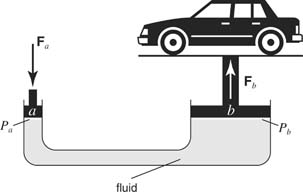A fluid is a substance that cannot maintain its own shape but takes the shape of its container. Fluid laws assume idealized fluids that cannot be compressed.
Density and pressure
Density and Pressure
The density (ρ) of a substance of uniform composition is its mass per unit volume: ρ = m/ V. In the SI system, density is measured in units of kilograms per cubic meter.
Imagine an upright cylindrical beaker filled with a fluid. The fluid exerts a force on the bottom of the container due to its weight.Pressure at a point in a fluid is directly proportional to the density of the fluid and the depth of the point Pressure is defined as the force per unit area: P = F/ A , or in terms of magnitude, P = mg/A, where mg is the weight of the fluid.
The SI unit of pressure is N/m2, called a pascal.
The pressure at the bottom of a fluid can be expressed in terms of the density (ρ) and height (h) of the fluid:

or
P = ρ g h,
where
P is the fluid pressure at a point,
ρ is the density of the fluid,
g is the acceleration due to gravity, and
h is the depth of the point.
The pressure at any point in a fluid acts equally in all directions. This concept is sometimes called the basic law of fluid pressure.
From the equation,
We can see that pressure in liquid increases with the depth and density of liquid
but not the volume or cross sectional area of liquid.
A liquid will always settle at a common level.If the height of water is different across the columns, the pressure difference will cause the height of each column to drop or rise until a common level is reached.
At Equilibrium, or at any point along the same vertical height, the pressure will be the same.

Transmission of pressure in liquids
Pascal's principle
Pascal's principle may be stated thus:
The pressure applied at one point in an enclosed fluid under equilibrium conditions is transmitted equally to all parts of the fluid.
This is because fluids such as liquids are incompressible.This means that if pressure is applied to a trapped liquid, the pressure will be transmitted to all other parts of the liquid.
This rule is utilized in hydraulic systems. In Figure 1 , a push on a cylindrical piston at point a lifts an object at point b.

Figure 1
Pascal's principle is used to easily lift a car.
Let the subscripts a and b denote the quantities at each piston. The pressures are equal; therefore,
P a = P b
Substitute the expression for pressure in terms of force and area to obtain
f a / A a = ( F b / A b )
Substitute π r2 for the area of a circle, simplify, and solve for
F b : F b =( F a )( r b 2/ r a 2)
Because the force exerted at point a is multiplied by the square of the ratio of the radii and
r b > r a ,
a modest force on the small piston a can lift a relatively larger weight on piston b
Could you please explain more about the manometer? Thankyou for the explanations! :) This was really helpful.
ReplyDelete